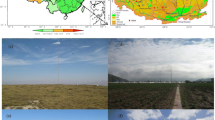Abstract
The Sanjiang Plain is situated in northeast China. It is one of the areas where marshes are distributed concentratedly and widely in China.Carex lasiocarpa marsh and the marsh withCarex lasiocarpa as dominative species are distributed widely. We choseCarex lasiocarpa marsh as observation object in 1990 and 1991. Marsh evapotranspiration includes transpiration of marsh plants and evaporation of water surface. We used evaporimeters to observe the water level, and calculated the water level amplitude. The evapotranspiration of the marsh is one or two times more than the evaporation of water surface in growing season. The larger the vegetation coverage, the greater the daily evapotranspiration. When the vegetation coverage of marsh is less than 10%, the daily evapotranspiration of marsh is close to the evaporation of water surface. The difference between the evapotranspiration of marsh and the evaporation of water surface in sunny days is more than that in cloudy days.
Similar content being viewed by others
References
陈 久宇, 观测数据的处理方法上海: 上海交通大学出版社, 1986.
Author information
Authors and Affiliations
Rights and permissions
About this article
Cite this article
Chen, G., Lu, X. A study on marsh evapotranspiration in the Sanjiang plain. Chinese Geographical Science 4, 159–167 (1994). https://doi.org/10.1007/BF02664298
Issue Date:
DOI: https://doi.org/10.1007/BF02664298




